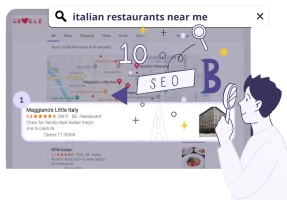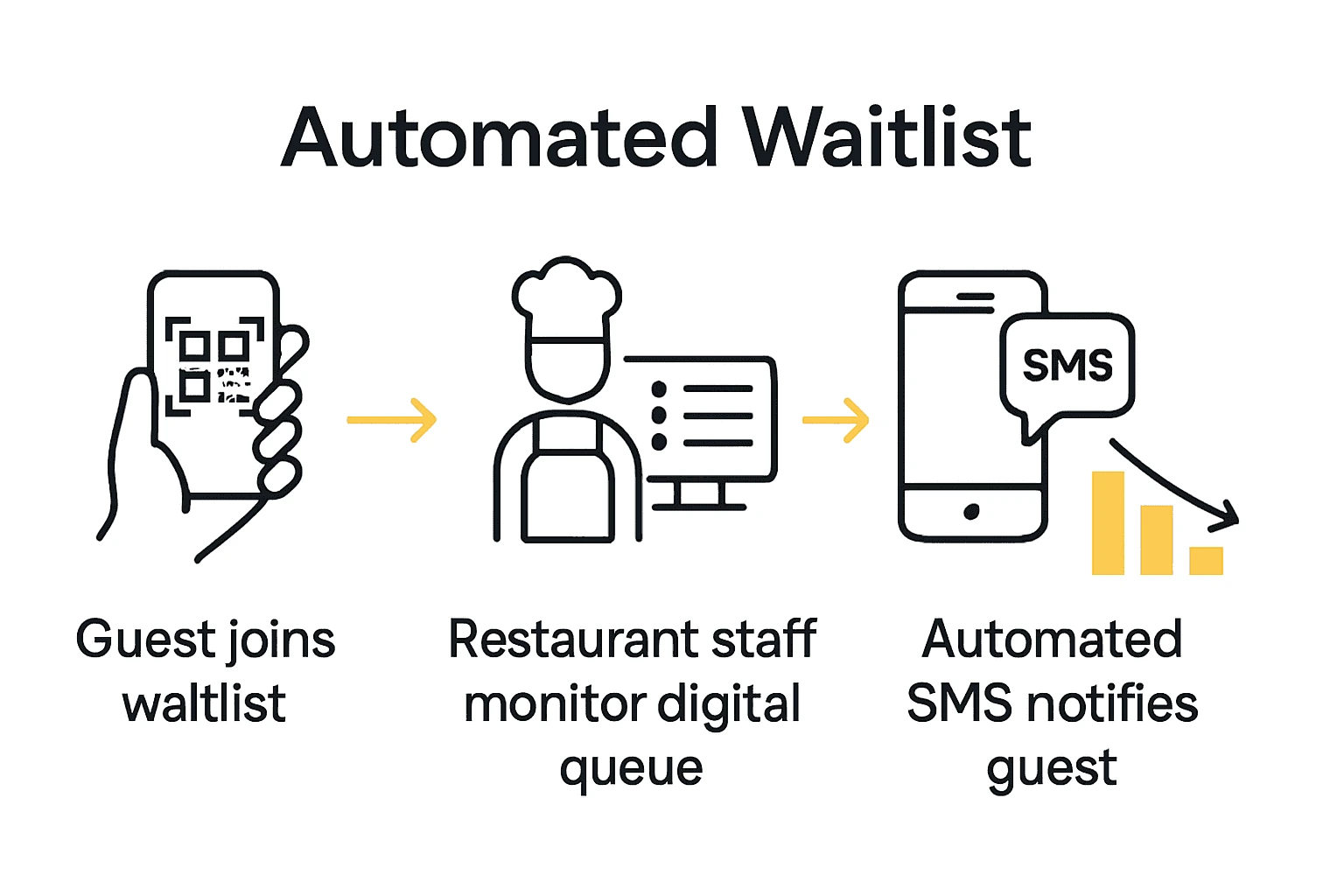Did you know that restaurants using digital waitlist tools can reduce walkouts by up to 20 percent? Long waits and crowded lobbies often leave guests frustrated, yet smart waitlist management can turn these moments into smoother, more enjoyable experiences. Discover how modern strategies and technology not only speed up seating but also improve customer satisfaction, bringing real results to busy dining spots.
Table of Contents
Defining Waitlist Management and Its Purpose
Waitlist management represents a strategic approach restaurants use to handle customer flow during peak periods when seating capacity is full. At its core, waitlist management involves systematically organizing and tracking potential diners waiting to be seated, transforming what could be a chaotic experience into a smooth, customer-friendly process. According to research from ajird.journalspark.org, effective waiting line management strategies significantly impact customer satisfaction in quick service restaurants. Key factors like perceived waiting time, customer engagement, staff empathy, and the waiting environment play critical roles in determining how guests experience their pre-dining waiting period. The primary purposes of waitlist management extend beyond simply keeping track of waiting customers. These purposes include:
-
Optimizing Restaurant Capacity: Efficiently managing the flow of guests to maximize table turnover and revenue
-
Enhancing Customer Experience: Providing transparent, fair waiting processes that reduce guest frustration
-
Reducing Abandonment Rates: Giving customers realistic wait time expectations to prevent them from leaving
-
Collecting Valuable Data: Tracking wait times, peak periods, and customer preferences for strategic planning
Successful waitlist management transforms what could be a stressful waiting experience into an opportunity for positive customer interaction. By implementing thoughtful strategies, restaurants can turn potential waiting time challenges into competitive advantages. Learn more about mastering this approach in our guide on restaurant waiting list management.
Types of Waitlist Systems for Restaurants
Restaurant waitlist systems have evolved dramatically, offering diverse technological solutions to manage customer flow and enhance dining experiences. These systems range from traditional manual methods to sophisticated digital platforms that transform how restaurants handle customer queuing and engagement. According to research from qminder.com, modern waitlist systems like Eat App and NextME provide advanced features beyond simple queuing. These cloud-based platforms combine reservation management, customer relationship management (CRM), and interactive waiting room technologies to keep guests engaged and informed during wait periods.
Restaurants can typically choose from several key types of waitlist systems:
Here’s a comparison of common restaurant waitlist system types and their key characteristics:
|
System Type |
Main Tools Used |
Key Features |
Typical Use Case |
|
Manual Clipboard |
Pen and paper |
Simple tracking |
Small, low-tech venues |
|
Digital Tablet/Smartphone |
Mobile app |
Real-time updates |
Mid-size restaurants |
|
Standalone Kiosk |
Touchscreen terminal |
Self check-in |
High-traffic, fast casual |
|
Integrated Management Platform |
All-in-one software |
Reservations link |
Larger or multi-site enterprises |
-
Manual Clipboard System: Traditional method using pen and paper tracking
-
Digital Tablet/Smartphone Systems: Mobile apps allowing real-time queue management
-
Standalone Waitlist Kiosks: Dedicated hardware for guest check-in and tracking
-
Integrated Restaurant Management Platforms: Comprehensive systems combining waitlist, reservations, and table management
Each waitlist system offers unique advantages, and the right choice depends on a restaurant’s specific operational needs, customer volume, and technological infrastructure. Some systems provide additional features like SMS notifications, estimated wait times, and guest preference tracking. These innovations help transform waiting from a potential frustration into an opportunity for enhanced customer service.
Restaurants interested in exploring modern waitlist solutions can learn more about online waitlist technologies to streamline their guest management processes.
Key Features of Effective Waitlist Solutions
Effective waitlist solutions have transformed from simple queuing mechanisms into sophisticated customer management tools that can dramatically improve restaurant operations and guest experiences. These advanced systems go far beyond basic tracking, offering intelligent features that help restaurants optimize their seating, engagement, and customer satisfaction strategies. According to research from tablecheck.com, modern waitlist solutions now provide automated features that revolutionize guest management. These include SMS and QR code-based guest additions, real-time notifications, multilingual support, and comprehensive performance reporting, which collectively enhance both operational efficiency and customer experience.
The key features of top-tier waitlist solutions typically encompass:
Real-Time Tracking
: Precise, dynamic monitoring of guest queue positions and wait timesCommunication Tools
: Automated SMS notifications, estimated wait time updates, and seamless guest communicationReservation Integration
: Smooth synchronization with existing booking and table management systemsGuest Profiling
: Ability to track customer preferences, dining history, and special requirementsPerformance Analytics
: Detailed reporting on wait times, table turnover rates, and customer flow patterns
These technological innovations represent more than just convenience—they’re strategic tools that can significantly impact a restaurant’s bottom line. By providing transparent, engaging waiting experiences, restaurants can reduce customer frustration, minimize walkouts, and create memorable service interactions. Restaurants looking to streamline their guest management can find comprehensive insights in our guide on mastering restaurant waiting lists.
Automating Waitlists for Operational Efficiency
Automation has become a game-changing strategy for restaurants seeking to streamline their operations and enhance guest experiences. Waitlist automation represents a critical technological advancement that transforms how restaurants manage customer flow, reduce staff workload, and improve overall operational efficiency. According to research from tablecheck.com, automated waitlist systems dramatically reduce staff workload by enabling guests to join waitlists via SMS or QR codes, receive real-time updates, and manage reservations seamlessly. Additional insights from tablesready.com highlight how digital solutions can track queues on mobile devices, send text notifications when tables are ready, and significantly minimize manual guest management processes.
Key benefits of waitlist automation include:
Reduced Staff Burden: Minimizing manual tracking and communication responsibilities
Enhanced Guest Experience: Providing transparent, real-time waiting information
Improved Communication: Automated notifications and updates directly to guests’ mobile devices
Data-Driven Insights: Capturing waiting time and customer flow analytics
Flexible Management: Enabling remote queue monitoring and management
Restaurants looking to optimize their operational workflows can significantly benefit from implementing automated waitlist technologies. By embracing these innovative solutions, establishments can transform potential waiting time frustrations into opportunities for enhanced customer engagement. For restaurants interested in exploring cutting-edge restaurant automation tools, the potential for improved efficiency and customer satisfaction is substantial.
Enhancing Guest Experience with Waitlist Tools
Waitlist management has evolved from a simple queuing system to a sophisticated guest experience enhancement strategy. Guest-centric technology now allows restaurants to transform potentially frustrating waiting periods into engaging, personalized interactions that can significantly improve customer satisfaction and loyalty. According to research from tablecheck.com, modern waitlist tools are designed to enhance guest experience by providing real-time updates, dramatically reducing perceived wait times, and offering guests the flexibility to wait off-premises. This approach directly addresses one of the most significant pain points in dining out—the uncertainty and potential boredom associated with waiting for a table.
Key guest experience enhancements through waitlist tools include:
Transparent Communication: Real-time wait time estimates and status updates
Flexibility: Ability to join waitlists remotely and manage queue position
Personalization: Tracking guest preferences and past dining history
Engagement: Interactive features that make waiting more enjoyable
Reduced Anxiety: Clear information about table availability and estimated seating times
By implementing intelligent online waitlist solutions, restaurants can turn waiting from a potential source of frustration into an opportunity for building positive customer relationships. These tools not only manage queues efficiently but also create memorable experiences that encourage repeat visits and positive word-of-mouth recommendations.
Common Mistakes to Avoid in Waitlist Management
Effective waitlist management requires strategic thinking and technological sophistication. Many restaurants unknowingly undermine their guest experience and operational efficiency by perpetuating outdated practices and overlooking critical management strategies. According to research from tablesready.com, one of the most significant mistakes restaurants make is relying on manual systems like pen and paper, which inherently lead to inefficiencies and potential errors. Similarly, insights from chowbus.com highlight the risks of failing to implement a centralized waitlist system, particularly for multi-location establishments, which can result in inconsistent guest experiences and fragmented operational processes.
Common waitlist management mistakes include:
Manual Tracking: Using outdated paper-based systems prone to human error
Inconsistent Processes: Lack of standardized waitlist management across different restaurant locations
Poor Communication: Inadequate real-time updates for waiting guests
Inflexible Systems: Not adapting to changing customer expectations and technological capabilities
Inefficient Queue Management: Failing to optimize seating and table turnover rates
Restaurants seeking to overcome these challenges can benefit from comprehensive crowd management strategies. By embracing digital solutions and implementing systematic approaches, establishments can transform potential operational bottlenecks into streamlined, guest-friendly experiences that drive satisfaction and repeat business.
Transform Your Restaurant’s Waitlist Into a Seamless Experience
Managing a busy restaurant comes with unique challenges, especially when it comes to handling long waitlists and keeping guests happy. This article highlights key pain points such as unpredictable wait times, poor communication, and inefficient manual tracking — all of which can damage your customers’ experience and reduce your revenue potential. Efficient waitlist management that combines real-time updates, clear communication, and automated workflows is essential to turn waiting from a frustration into an opportunity for guest engagement. At Tableo, we understand these challenges and offer a comprehensive SaaS platform tailored to optimise your reservation and waitlist processes. With features like digital floor plans, automated SMS notifications, and integrated guest profiles, you can reduce no-shows and improve operational efficiency at every step. Discover how our solution supports flexible queue management and guest experience enhancements by visiting Tableo.
Looking to modernise your waitlist system and create happier customers right now?
Explore powerful automation and analytics tools designed specifically for restaurants in our detailed guides on restaurant waiting list management and see how integrating bookings across multiple channels can boost efficiency and loyalty. Don’t let outdated systems hold your business back. Visit Tableo today and start transforming your guest experience with smart waitlist management.
Frequently Asked Questions
What is waitlist management and why is it important for restaurants?
Waitlist management is a strategic approach that restaurants use to handle customer flow when seating capacity is full. It involves organizing and tracking waiting customers to enhance their experience, optimize table turnover, reduce abandonment rates, and collect valuable data for future planning.
What types of waitlist systems are available for restaurants?
Restaurants can choose from several types of waitlist systems, including manual clipboard methods, digital tablet/smartphone apps, standalone kiosks, and integrated management platforms that combine waitlist, reservation, and customer relationship management features.
How can automation improve waitlist management in restaurants?
Automation in waitlist management helps reduce staff workload by allowing guests to join waitlists via SMS or QR codes, receive real-time updates, and manage reservations efficiently. It enhances guest experience by providing transparency and minimizing manual tracking processes.
What are common mistakes to avoid in waitlist management?
Common mistakes include relying on manual tracking methods, having inconsistent processes across different locations, failing to provide real-time updates to waiting guests, and not adapting to changing customer expectations or optimizing seating arrangements.

Unlock the tips that will help you stand out from the crowd and get more bookings!

Learn how to save time, reduce stress and fill your restaurant while you sleep!

Stephanie Paris
Gen-Z marketing coordinator bringing fresh energy to web and graphic design, with a weekend habit of chasing adventure.
-
Previous Post
Managing Café Bookings: Streamline Reservations Easily










